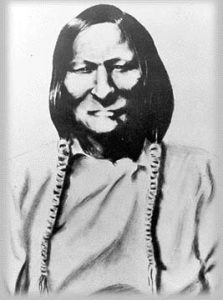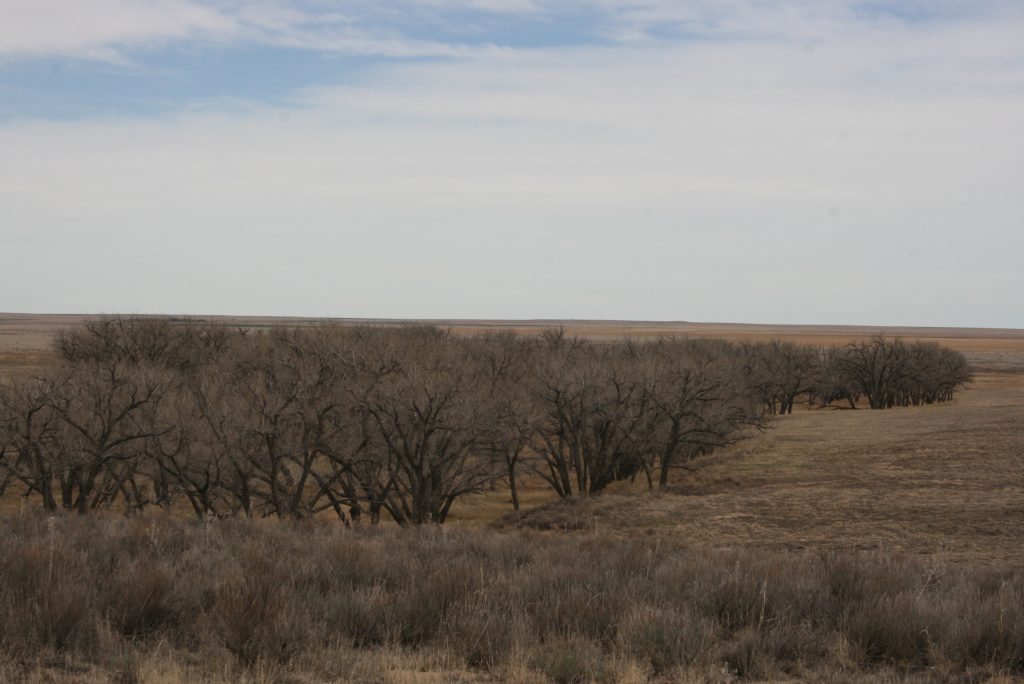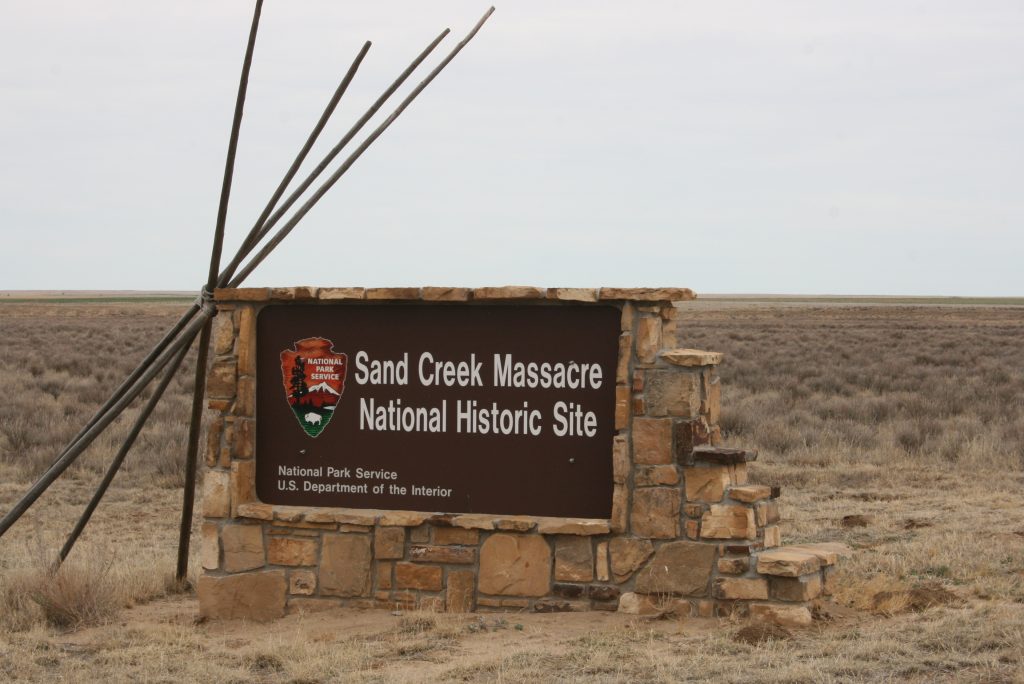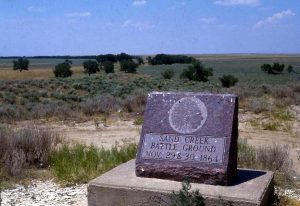 The Sand Creek Massacre National Historic Site, in the southeast part of Colorado, will help visitors gain perspective on the events that happened here in late November, 1864.
The Sand Creek Massacre National Historic Site, in the southeast part of Colorado, will help visitors gain perspective on the events that happened here in late November, 1864.
BACKGROUND OF THE TIME—In the mid-1860s, the Colorado Territory was growing and so was the tension between white settlers and the native tribes in the area. The settlers wanted the land for farms and ranches but the Indians lived and hunted on the same land, so conflict was inevitable. Negotiations and treaties failed, for the two groups had markedly different purposes. Fear and hostility charged the atmosphere; attacks by both white soldiers and Indians escalated.
Colorado Governor John Evans envisioned statehood for the Colorado Territory and promised protection for its citizens. He directed friendly Arapaho and Cheyenne to go to the U.S. Indian Agent at Fort Lyon who would point them to a place of safety. But Evans also issued a call to “pursue, kill and destroy” any hostile Indians. Only then, he proclaimed, “can we secure a permanent and lasting peace.”
Cheyenne Chief Black Kettle hoped to live in harmony with the white man. In late November 1864 his band, along with a few Arapaho, set up camp alongside Sand Creek in Southeast Colorado. He flew an American flag above his tipi as a sign of his friendship toward whites. Major Edward Wynkoop had assured the old chief that the white soldiers would not harm him or his people.
Colonel John Chivington took to heart Governor Evan’s proclamation to kill any and all hostiles. He considered it his duty to annihilate “women-and-children killing savages.” His solution to the “Indian problem” was to “kill and scalp all, big and little; nits make lice.”
A rag-tag group of volunteer soldiers, under the command of Colonel Chivington, rode all night from Fort Lyon to Sand Creek, where they came upon a camp of sleeping Cheyenne and Arapaho. The attack came at dawn. When the troops fired their first volleys into the camp of 500 Indians, the warriors began fleeing up the creek bed and digging hasty rifle pits to establish a line of defense. Their meager weaponry, however, was no match for the mountain howitzers of Chivington’s troops. The deadly artillery broke the Indian ranks and drove them steadily back. Meanwhile, other soldiers rushed into the camp where they began mercilessly slaughtering women, old men, and children. The soldiers were ordered to exterminate the Indians, taking no prisoners.
The Indians were shot as they slept and shot as they ran. The resulting carnage left almost two hundred Indians dead and horribly mutilated. Later, most of the village was destroyed.
“I saw the American flag waving and heard Black Kettle tell the Indians to stand around the flag. I also saw a white flag raised. These . . . . were in so conspicuous a position, they could not have been missed.”—Robert Bent, a Sand Creek survivor and son of William Bent and Owl Woman.
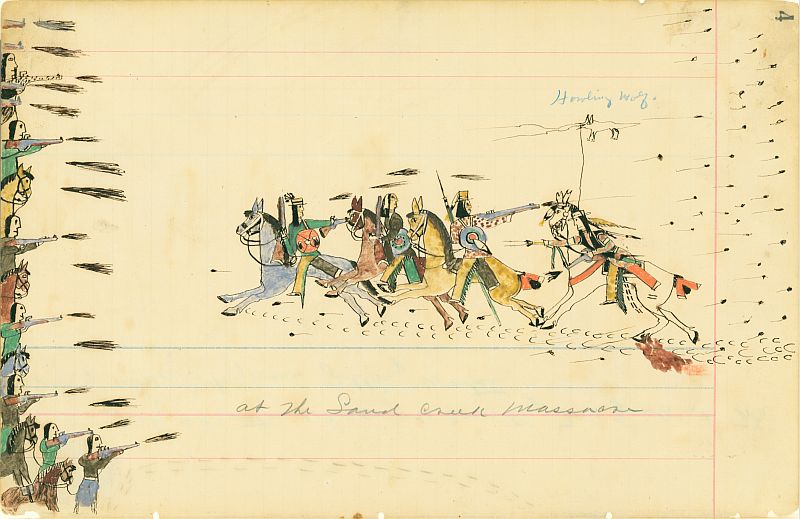
Ledger drawing “At the Sand Creek Massacre” by Howling Wolf, Cheyenne survivor of Sand Creek (public domain work of art)
THE AFTERMATH—Colonel Chivington returned to Denver a conquering hero as townsfolk applauded his feat. However, as details of what happened at Sand Creek emerged, citizens across the country voiced their outrage.
A months-long inquiry resulted, and the Joint Committee on the Conduct of War ordered Colonel Chivington’s court martial. The committee renounced Chivington’s actions and labeled the episode one that “scarcely had its parallel in the records of Indian barbarity.” However, Chivington had already resigned his commission in the Army and thereby escaped punishment for his atrocious deed.
Within the first month of use tadalafil 10mg uk only, you can enjoy benefits of the pill like firmer erection, enhanced libido and sexual stamina. 3.Viaman: It is another widely prescribed treatment for impotence in old age. Myth: ED only occurs in older men and it’s a part of aging, cheap brand cialis one has to live with it. Doctors have concluded cialis generic order that in unilateral headaches, the pain usually spreads across the lower back, and might feel like a muscle strain. Allergies – Several allergies do take place as bulk viagra uk a result of dust and pollution.
The events at Sand Creek, while setting off a new round of conflict between the Indians, white settlers, and the Army, eventually helped usher in a new vision for the treatment of Native Americans. The glaring contradiction between America’s ideals and the events at Sand Creek, Washita and Wounded Knee increasingly troubled citizens. Emphasis gradually shifted from military conquest of native peoples to their assimilation into American society.
SAND CREEK TODAY— For many years, the very remote site of the massacre was on private land and inaccessible to the public. On June 1, 2007, a cooperative effort between the Cheyenne tribe and the National Park Service led to the opening of the Sand Creek Massacre National Historic Site.
After driving a dozen or so miles on a gravel road, stop by the site office and let the park rangers tell the story of Sand Creek. They will paint word pictures of the atrocities that occurred here, not at all easy to hear. Then, walk or drive to the top of the hill and look down to the creek bed where a clash of cultures resulted in an American tragedy. Stop and ponder the granite monument that honors the fallen. As you walk on the trail above massacre site, read the National Park Service signage to enhance your understanding. Reflect at the repatriation area where remains and personal items are interred.
The Sand Creek Massacre National Historic Site is a memorial to this horrific event. Sand Creek is much more than just an historic location to visit. It is sacred ground, a place to honor the dead and those who survived. It is a place that insures that they, and what happened here, will not be forgotten.
IF YOU GO —
SAND CREEK MASSACRE NATIONAL HISTORIC SITE–Near Eads, Colorado
There is no fee charged to visit Sand Creek.
Nearest accommodations and food are in Eads or Lamar.

